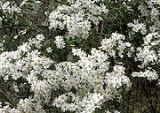
Olearia phlogopappa
Encyclopedia
Olearia phlogopappa is a species of flowering plant
in the family Asteraceae
. It occurs in open forest, woodland, heath and coastal shrubland in New South Wales
, Victoria
, and Tasmania
.
in 1806 in Novae Hollandiae Plantarum Specimen
and named Aster phlogopappus. In 1836 the species was transferred to the genus Olearia
by Augustin Pyramus de Candolle in Prodomus.
There are 6 varieties which are currently recognised:
Another cultivar, 'Havering Blush', is a hybrid between Olearia phlogopappa and Olearia lirata
.
Flowering plant
The flowering plants , also known as Angiospermae or Magnoliophyta, are the most diverse group of land plants. Angiosperms are seed-producing plants like the gymnosperms and can be distinguished from the gymnosperms by a series of synapomorphies...
in the family Asteraceae
Asteraceae
The Asteraceae or Compositae , is an exceedingly large and widespread family of vascular plants. The group has more than 22,750 currently accepted species, spread across 1620 genera and 12 subfamilies...
. It occurs in open forest, woodland, heath and coastal shrubland in New South Wales
New South Wales
New South Wales is a state of :Australia, located in the east of the country. It is bordered by Queensland, Victoria and South Australia to the north, south and west respectively. To the east, the state is bordered by the Tasman Sea, which forms part of the Pacific Ocean. New South Wales...
, Victoria
Victoria (Australia)
Victoria is the second most populous state in Australia. Geographically the smallest mainland state, Victoria is bordered by New South Wales, South Australia, and Tasmania on Boundary Islet to the north, west and south respectively....
, and Tasmania
Tasmania
Tasmania is an Australian island and state. It is south of the continent, separated by Bass Strait. The state includes the island of Tasmania—the 26th largest island in the world—and the surrounding islands. The state has a population of 507,626 , of whom almost half reside in the greater Hobart...
.
Description
Oleraia phlogopappa grows to between 0.3 and 3 metres in height. The leaves are quite variable, but are usually grey-green with minute hairs on the underside which impart a whitish or yellowish appearance. The leaf margins are often bluntly toothed. White, pink or mauve "daisy" flower heads around 20-25 mm in diameter are mainly produced in spring and early summer.Taxonomy
The species was first formally described by Jacques LabillardièreJacques Labillardière
Jacques-Julien Houtou de Labillardière was a French naturalist noted for his descriptions of the flora of Australia. Labillardière was a member of a voyage in search of the La Pérouse expedition...
in 1806 in Novae Hollandiae Plantarum Specimen
Novae Hollandiae Plantarum Specimen
Novae Hollandiae Plantarum Specimen is a two volume work describing the flora of Australia. The author was the French botanist Jacques Labillardière, who visited the region in 1792 with the d'Entrecasteaux expedition...
and named Aster phlogopappus. In 1836 the species was transferred to the genus Olearia
Olearia
Olearia is a genus of flowering plants belonging to the family Asteraceae. There are about 130 different species within the genus found mostly in Australia, New Guinea and New Zealand...
by Augustin Pyramus de Candolle in Prodomus.
There are 6 varieties which are currently recognised:
- O. phlogopappa var. angustifolia (Hook.f.) W.M.Curtis
- O. phlogopappa var. brevipes (Hook.f.) W.M.Curtis
- O. phlogopappa var. flavescens (Hutch.) J.H.Willis
- O. phlogopappa var. microcephala (Hook.f.) W.M.Curtis
- O. phlogopappa (Labill.) DC. var. phlogopappa
- O. phlogopappa var. salicifolia (Hook.f.) W.M.Curtis
Cultivation
The species withstands moderate frost and drought, but prefers moist conditions and a well drained soil in a sunny or partially shaded position. Pruning is required to stop plants becoming spindly. Cuttings are the usual method of propagation as seed may be unreliable.Cultivars
A number of cultivars are commercially available including:- 'Blue Gem'
- 'Brevipes'
- 'Cana'
- 'Combers'
- 'Comber's Blue'
- 'Comber's Pink'
- 'Nyman's Splendens'
- 'Pink Gem'
- 'Salicifolia'
- 'Sawtooth'
- 'Splendens'
- 'Splendens Blue'
- 'Splendens Lavender'
- 'Splendens Pink'
- 'Tournaig Titch'
Another cultivar, 'Havering Blush', is a hybrid between Olearia phlogopappa and Olearia lirata
Olearia lirata
Olearia lirata is a species of flowering plant in the Asteraceae family. It occurs in moist forest and scrub in New South Wales, Victoria, and Tasmania....
.

